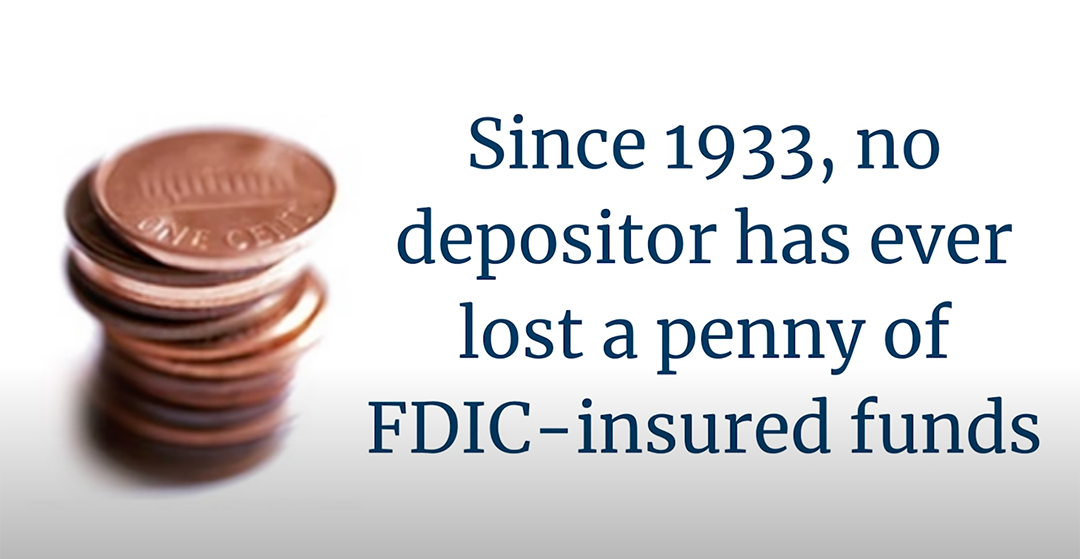FDIC Insurance
Your FDIC Insured Deposits

FDIC Insured Bank Deposits are Safe
In light of recent developments related to the coronavirus, the Federal Deposit Insurance Corporation (FDIC) is reminding Americans that FDIC-insured banks remain the safest place to keep their money. The FDIC is also warning consumers of recent scams where imposters are pretending to be agency representatives to perpetrate fraudulent schemes.
Since 1933, no depositor has ever lost a penny of FDIC-insured funds.
Today, the FDIC insures up to $250,000 per depositor per FDIC-insured bank. An FDIC-insured account is the safest place for consumers to keep their money. Learn more about deposit insurance here. Some banks may have adjusted hours or services in compliance with Centers for Disease Control guidance on social distancing. Customers’ deposits remain safe in these banks, as does customer access to their funds. Banks continue to offer ATM, mobile, or online banking services, and many continue to provide services via drive-through windows.
Electronic Deposit Insurance Estimator (EDIE)
FDIC's Electronic Deposit Insurance Estimator (EDIE) is a tool that can help consumers determine deposit insurance coverage based on accounts they may already have with a bank or accounts they are considering opening. The agency recommends using EDIE for questions about FDIC deposit insurance coverage.
During these unprecedented times, consumers may receive false information regarding the security of their deposits or their ability to access cash. The FDIC does not send unsolicited correspondence asking for money or sensitive personal information. The agency will never contact people asking for personal details, such as bank account information, credit and debit card numbers, Social Security numbers, or passwords.
Consumers may also be contacted by persons who claim to be employed by an agency, bank, or another entity. These scams may involve a variety of communication channels, including emails, phone calls, letters, text messages, faxes, and social media. Scammers might also ask for personal information such as bank account numbers, Social Security numbers, dates of birth, and other details that can be used to commit fraud or sell a person's identity. Consumers should not provide this information.
Additional resources for consumers include:
- FDIC: Fraud Against the Elderly. How you can stop and prevent financial abuse
- FDIC: Is My Money Insured by the FDIC? What to consider about using a nonbank
- FDIC: Coronavirus (COVID-19) Information for Bankers and Consumers
- FDIC Consumer News: How FDIC Protects Customers – February article
- FDIC: Avoiding Scams & Scammers
- FDIC Tips for Small Businesses - PDF (528KB)
- FDIC Tips for Reaching Out to Creditors and Managing Debt
- FDIC Knowledge Center portal with access to Frequently Asked Questions
Frequently Asked Questions:
FDIC Insurance Coverage
The Federal Deposit Insurance Corporation ("FDIC") is an independent agency of the United States government that protects against the loss of insured deposits if an FDIC-insured bank or savings institution fails. FDIC deposit insurance is backed by the full faith and credit of the United States government. Since the FDIC was established, no depositor has ever lost a single penny of FDIC-insured funds.
FDIC insurance covers funds in deposit accounts including checking and savings accounts, money market deposit accounts, and certificates of deposit accounts. FDIC insurance does not, however, cover other financial products and services that insured banks may offer, such as stocks, bonds, mutual fund shares, life insurance policies, annuities or municipal securities.
FDIC deposit insurance coverage is automatic. Depositors do not need to apply or even request coverage.
Basic FDIC Deposit Insurance Coverage Limits*
- Single Accounts (owned by one person) $250,000 per owner
- Joint Accounts (two or more persons) $250,000 per co-owner
- IRAs and certain other retirement accounts $250,000 per owner
- Trust Accounts $250,000 per owner per beneficiary subject to limitations and requirements
For complete information about FDIC insurance coverage of accounts, please visit www.fdic.gov.
*Note: These deposit insurance coverage limits refer to the total of all deposits that an account holder(s) has at each FDIC-insured bank. The listing above shows only the most common ownership categories that apply to individual and family deposits, and assumes that all FDIC requirements are met.